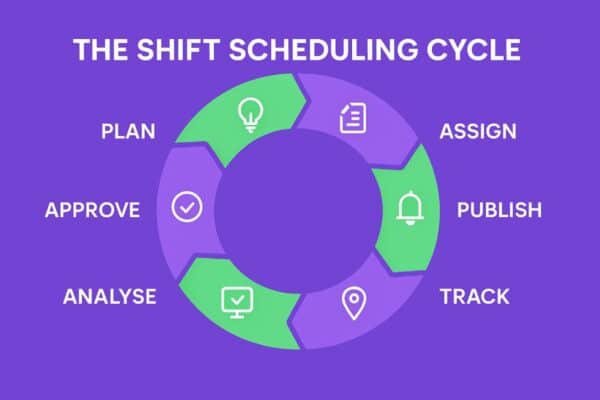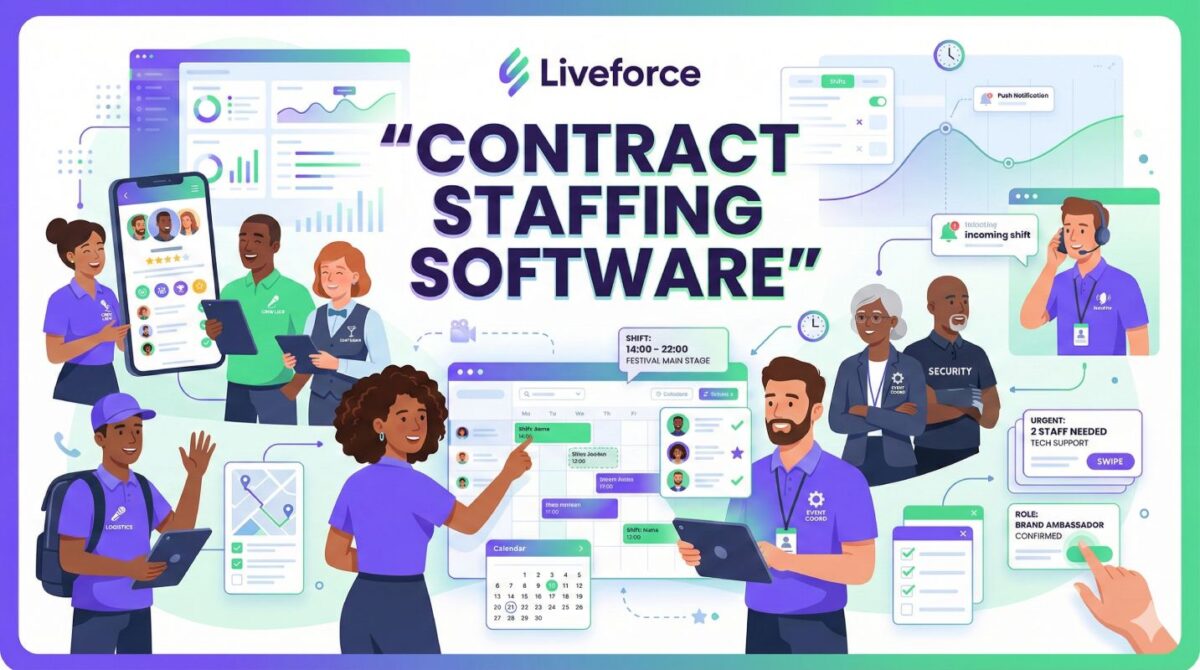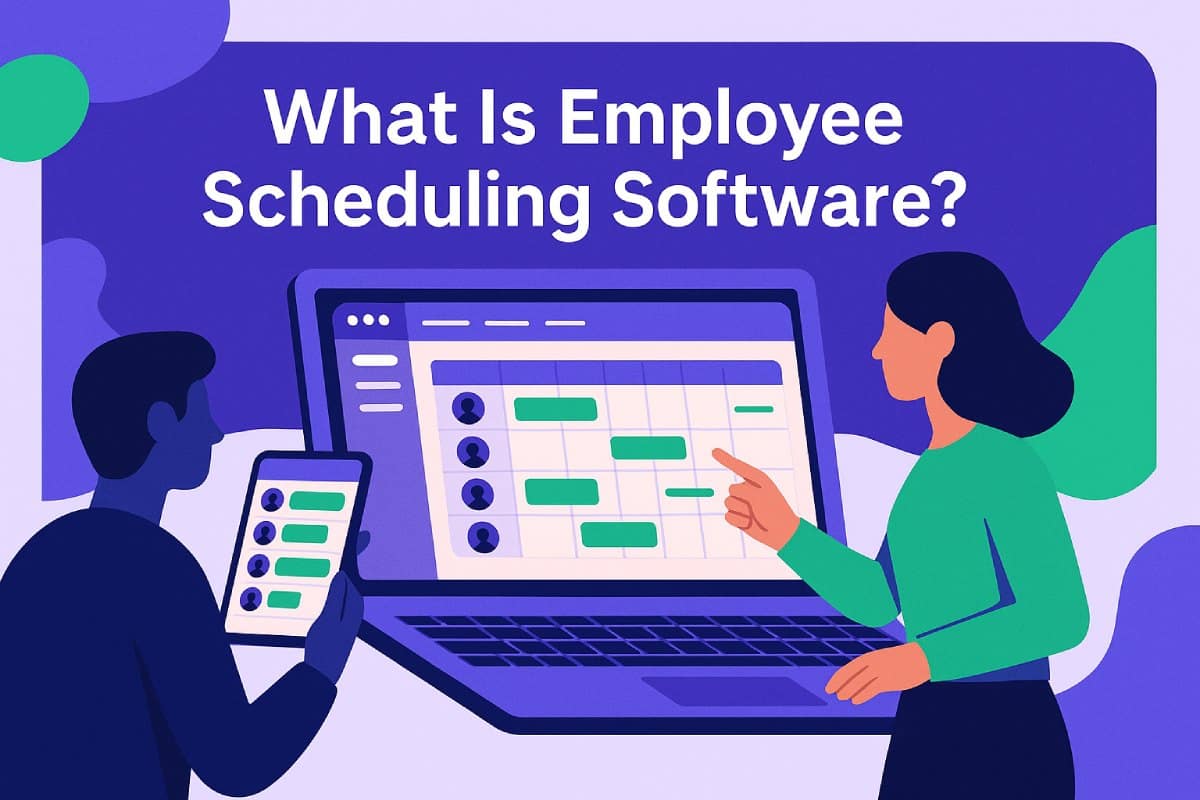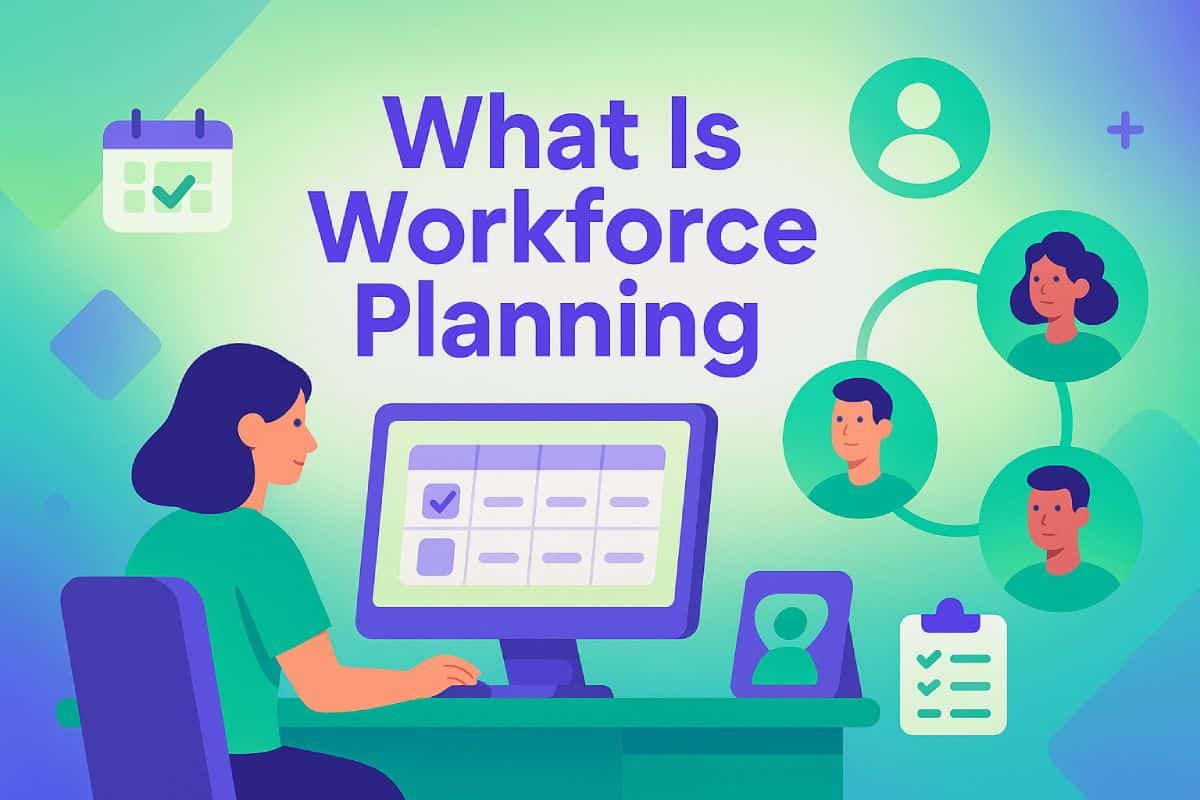Managing staff across multiple events, locations, and shift patterns is one of the toughest operational challenges for agencies. Whether you run an event staffing agency, an experiential marketing team, a festival crew, or a hospitality operation, you already know how quickly a rota can spiral out of control.
For agencies that prefer a traditional rota view, rota scheduling software provides a simple way to see staff coverage at a glance.
Shift changes. No-shows. Double-bookings. Workers are missing updates. Compliance issues. Endless spreadsheets.
This is where shift scheduling software becomes essential. In this ultimate guide, we explain what it is, why it matters, and how it helps you manage temporary staff, permanent shift workers, and volunteers more efficiently.
What Is Shift Scheduling Software?
Shift scheduling software is a digital tool that helps organisations plan, assign, and manage staff shifts. Instead of using spreadsheets or manual systems, you can build rotas, communicate updates, monitor compliance, and track hours all in one place.
For event teams, particularly, the right tool offers:
- Multi-event scheduling
- Real-time communication
- Compliance checks
- Automated scheduling rules
- Timesheets and payment tracking
- Mobile access for staff
This is why it is one of the most useful technologies for agencies managing large temporary workforces.
Why Agencies Need Shift Scheduling Software Today
Across events, hospitality, sports, and charities, staffing expectations have changed. Teams now manage:
- Temporary workers
- Part-time staff
- Freelancers
- Volunteers
- Mixed teams across several locations
- High-volume event days
Manual systems simply cannot keep up. Shift scheduling software allows you to coordinate all of this with ease, especially when you operate at scale.
Who Benefits Most From Shift Scheduling Software?
We work closely with a wide range of organisations, and the same patterns appear across all sectors.

1. Event Staffing Agencies
They manage hundreds or thousands of crew at once. They need a rota system that prevents double-bookings and improves communication.
With so many moving parts, you need shift planning tools that allow you to react quickly when clients change requirements at short notice. Using an event staff scheduling system helps you keep every role covered, even during peak periods.
It also gives you confidence that staff are compliant and allocated correctly across multiple projects.
2. Experiential Marketing Agencies
Campaigns often require rotating shifts, branded teams, and fast turnaround times.
These teams also manage short activations across several locations, meaning multi-location scheduling software becomes essential. When shifts change during a live activation, instant mobile updates ensure staff never miss new instructions.
A flexible rota scheduling software setup also helps agencies maintain brand consistency by ensuring the right ambassadors are assigned.
3. Hospitality Staffing Suppliers
Restaurants, catering teams, and venues need rotating rotas and clear shift timelines.
These environments often deal with changing guest numbers, making it difficult to predict staffing levels accurately. With temporary staff scheduling software, hospitality teams can scale up or down without disrupting service quality.
The right tools also help track hours, compliance documents, and role-specific skills.
4. Festival Staffing Suppliers
Festivals run across multiple days and locations, making shift scheduling one of the biggest challenges.
These teams often manage a mix of paid staff, volunteers, and specialist crew, each with their own availability and skill sets. Multi-location scheduling software ensures you never place someone in two areas at once, especially when sites are far apart.
Real-time notifications also help keep everyone aligned during fast-moving festival operations.
5. Volunteer Coordinators & Charities
They often rely on volunteer shift scheduling software to plan roles, sign-ups, and shifts.
Volunteers usually give their time around other personal commitments, so having clear, accessible schedules increases attendance and reduces confusion. Automated reminders help keep people informed without extra admin.
A reliable system also improves the volunteer experience, encouraging them to return for future events.
6. Venue Staffing Teams
These teams typically need employee shift scheduling software for regular weekly rotas and peak-hour coverage.
Venues often operate long hours, meaning staffing levels must adjust smoothly throughout the day. Using a software solution helps managers fill gaps quickly when availability changes.
It also supports fair, transparent shift allocation, which improves staff satisfaction and retention.
7. Sports Event Staffing Agencies
Sporting fixtures require precise staffing ratios, rotating shifts, and rapid communication.
These events often run across large venues with several zones, meaning teams benefit from multi-location scheduling software to avoid overlap and ensure full coverage. With crowd flows changing throughout the match or event, shift planning tools help you adjust staffing levels in real time.
Automated notifications also keep stewards, hospitality staff, and support teams updated instantly when schedules change.
Key Features To Look For In Shift Scheduling Software
1. Automated Scheduling
Good software offers automatic shift scheduling software that:
- Assigns the best available staff
- Avoids conflicts
- Follows your rules
- Reduces admin time
2. Mobile App For Staff
Shift confirmations, updates, and reminders should appear instantly on a worker’s phone.
3. Compliance & Documentation
Agencies need confidence that every worker:
- Holds the right documents
- Has up-to-date certifications
- Meets event or venue requirements
4. Multi-Event Scheduling
If your organisation runs multiple projects at once, you need scheduling software that can manage:
- Overlapping shifts
- Different venues
- Varied team sizes
- Complex roles
If your teams operate across several venues or regions, multi-location scheduling software ensures you never double-book staff between sites.
5. Timesheets & Payments
A built-in timesheet system helps you remove manual inputs and reduce discrepancies.
6. Rotating Shift Patterns
The best systems include rotating shift schedule software tools that automate weekly or monthly cycles.
We also recommend using shift planning tools to save time on repeat schedules and improve accuracy across busy event periods.
Comparison Table: Types of Shift Scheduling Software:
| Type of Software | Best For | How It Helps |
|---|---|---|
| Shift scheduling software | Event staffing agencies and multi-project teams | Provides full multi-event scheduling and role allocation across large crew pools. |
| Employee shift scheduling software | Venues, hospitality teams, and permanent staff | Supports stable weekly rotas, predictable shifts, and ongoing staff coverage. |
| Scheduling software for shift work | Any organisation with shift-based operations | Offers clear rota visibility and real-time updates for teams working varied hours. |
| Shift work scheduling software | Teams managing both permanent and casual staff | Combines speed and flexibility for mixed workforce structures. |
| Automatic shift scheduling software | High-volume agencies and busy event teams | Uses automation to fill roles quickly, reduce admin, and avoid double-bookings. |
| Software for shift scheduling | General-purpose use across industries | Provides simple tools for building, publishing, and updating shifts. |
| Best shift scheduling software | Buyers comparing solutions | Helps organisations evaluate features, usability, and value before choosing a tool. |
| Rotating shift schedule software | Hospitality, venues, sports, and festivals | Automates cycling rotas and repeat patterns to save time and reduce errors. |
| Volunteer shift scheduling software | Charities, festivals, and community events | Manages volunteer sign-ups, availability, and communication. |
| Temporary staff scheduling software | Agencies working with large casual or freelance teams | Streamlines scheduling for fast-changing staff availability and busy event seasons. |
| Event staff scheduling system | Event agencies and experiential marketing teams | Coordinates staff for roles, shifts, and locations across multiple clients and activations. |
| Multi-location scheduling software | Teams operating across several venues or regions | Ensures clear coverage, prevents overlap, and simplifies assigning staff to the right site. |
| Rota scheduling software | Traditional rota-based businesses | Provides a simple rota-style interface for teams preferring classic scheduling layouts. |
| Shift planning tools | Managers building complex timetables | Helps create structured plans, forecast needs, and prepare for peak periods. |
How Shift Scheduling Software Works (Step-By-Step)
Here is a simple model of how systems like Liveforce operate:
Step 1: Build Events or Projects
Add the dates, locations, and roles you need.
This creates the structure your entire schedule will follow, making it easier to visualise staffing needs early. You can set requirements for each role, add notes, and prepare shifts before assigning anyone.
Having a clear event setup reduces errors and saves time later in the process.
Step 2: Add Staff or Volunteers
Upload or integrate your staff database. Tag skills, documents, and availability.
This helps you match the right people to the right roles without manual searching. You can also track compliance, making sure every worker meets event requirements.
A well-organised database speeds up scheduling, especially during busy periods.
Step 3: Auto-Schedule
Use automated tools to fill roles instantly.
This reduces admin and removes guesswork by matching staff with suitable roles based on availability and skills. Automatic scheduling is especially helpful when managing large temporary teams. It also minimises double-bookings and improves overall efficiency.
Step 4: Publish Shifts
Staff receive notifications in the mobile app.
Instant updates help keep everyone aligned, even when rotas change at the last minute. Publishing shifts digitally ensures staff always see the most accurate information. Clear communication reduces no-shows and confusion on event day.
Step 5: Monitor Attendance
Track who is on-site, who is late, and who is missing.
This gives you real-time insight into staffing coverage and allows you to respond quickly if gaps appear. Managers can communicate with staff directly from the system to resolve issues.
Attendance tracking also helps with reporting and compliance checks.
Step 6: Capture Timesheets
Approve hours digitally and send to payroll.
Digital timesheets reduce errors and remove the need for manual reconciliation. You can also set approval flows to match your internal processes. This helps you stay accurate and compliant, especially when dealing with large teams.
Step 7: Produce Reports
See staffing costs, hours worked, and shift performance.
Reporting gives you a clear picture of how your staffing strategy is working across events. You can review trends, identify gaps, and plan improvements for future projects. Accurate reporting also supports budgeting and client transparency.

Common Shift Scheduling Problems - And How Software Solves Them
| Challenge | Impact | Software Solution |
|---|---|---|
| Last-minute cancellations | Staff shortages | Real-time mobile updates |
| Compliance issues | Event risks | Document tracking tools |
| Double-bookings | Confusion & cost | Automated conflict checks |
| Manual timesheets | Payroll errors | Digital timesheets |
| Large multi-event demands | Overload | Multi-location scheduling |
| Volunteer coordination | Time-consuming | Volunteer shift scheduling software |
How Shift Scheduling Software Supports Temporary + Permanent Staff
Temporary staff
Perfect for agencies needing:
- Rapid scheduling
- Pool management
- Multi-event calendars
- Document tracking
Permanent shift staff
Ideal for:
- Rotating shift patterns
- Weekly schedules
- Venue staffing
- Hospitality rotas
For high-volume staffing agencies, temporary staff scheduling software makes it far easier to coordinate casual workers without relying on spreadsheets.
How Liveforce Aligns With These Needs
We built Liveforce to meet the challenges of modern agencies.

1. Automated Scheduling
Reduce admin and fill shifts quickly.
We use rules, tags, and availability to suggest the right people for each role so you are not starting from a blank rota every time. Automated scheduling helps you react faster when clients change timings or add extra shifts.
It also reduces the risk of double-bookings and missed roles.
2. Mobile Crew App
Staff stay updated wherever they are.
Crew can view confirmed shifts, accept or decline work, and see any changes in real time from their phone. We make it easy for them to update their availability so your team always works from accurate information.
Fewer missed messages means fewer no-shows and less last-minute stress.
3. Document Compliance
Track everything in one place.
You can store right-to-work documents, certificates, and role-specific requirements against each profile. We highlight missing or expired items so you do not have to chase them manually. This gives you confidence that only compliant staff are booked onto shifts.
4. Multi-Event Scheduling
Plan large-scale operations across venues.
You can see all projects in one calendar, which makes it easier to avoid clashes and manage busy periods. We help you move staff between events without losing track of where they should be.
This is especially useful for agencies running several clients and locations at the same time.
5. Digital Timesheets & Payments
Crew submit hours digitally and managers approve them in a few clicks, which speeds up payroll and reduces errors. We keep a clear record of who worked, when, and for how long, which supports transparent billing.
This also helps you spot patterns in staffing costs across different events.
Best Practices For Using Shift Scheduling Software
- Use templates to save time
- Create rotating patterns for repeat shifts
- Send updates early
- Use mobile reminders
- Automate wherever possible
- Track no-show patterns
- Integrate timesheets into payroll
By following these best practices, you can create a smoother scheduling process, reduce last-minute issues, and keep your team organised across every event. These simple habits help you get the most value from your shift scheduling software and support more reliable staffing outcomes.
Why Agencies Need Shift Scheduling Software Now
Shift scheduling software gives you clarity, control, and confidence. It helps you manage mixed workforces, support large events, reduce admin time, and give staff a much better experience.
If you want to streamline scheduling, improve communication, and keep staff compliant across every event, the right software makes all the difference.
Ready to transform how you schedule staff?
FAQs
1. What is shift scheduling software?
Shift scheduling software is a digital tool that helps you plan, assign, and manage staff shifts in one place. It removes manual admin, improves communication, and ensures every role is covered across events and locations.
2. How does shift scheduling software help event staffing agencies?
It gives you full visibility of crew availability, automates shift allocation, and reduces double-bookings. It also supports fast updates, multi-event planning, and mobile notifications for your team.
3. Can shift scheduling software manage temporary and volunteer staff?
Yes. Modern systems make it easy to schedule temporary workers, casual staff, and volunteers. You can track availability, send updates instantly, and ensure everyone has the correct shift information.
4. What features should event teams look for in shift scheduling software?
Look for automated scheduling, a mobile app for staff, compliance tracking, rota templates, multi-location scheduling, and digital timesheets. These features help you stay organised during busy event periods.
5. Why should agencies use shift scheduling software instead of spreadsheets?
Spreadsheets are slow to update and prone to errors. Shift scheduling software keeps everything centralised, reduces admin time, prevents double-bookings, and helps you respond quickly when shifts change.




